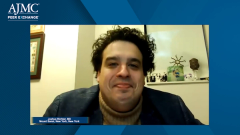
Frontline Therapy in Multiple Myeloma
Joshua Richter, MD, discusses long-term follow up data findings for multiple myeloma and their implications on front-line therapy options for patients.
Episodes in this series
Joshua Richter, MD: There were a lot of great updates at ASH the American Society of Hematology annual meeting 2020, and notable was the long-term updates from the MAIA trial [NCT02252172], which was daratumumab, lenalidomide, dexamethasone versus lenalidomide, dexamethasone in newly diagnosed transplant-eligible patients with myeloma. Although bortezomib, lenalidomide, dexamethasone [VRd] has been the standard for quite some time, there’s been sufficient data to support lenalidomide, dexamethasone alone as an upfront regimen for the older, frailer patients. This was confirmed in the FIRST trial, the MM-020 trial. What MAIA did was adopt the same approach we took in non-Hodgkin lymphoma when they started adding rituximab to every therapy; we’ve now added daratumumab to every therapy.
Now looking at DRd—daratumumab, lenalidomide, dexamethasone—versus lenalidomide, dexamethasone in the upfront setting for transplant-ineligible patients, we see not only is there a significant improvement in overall response rate, with overall response rates being around 93% in the DRd [daratumumab, lenalidomide, dexamethasone] group, but the progression-free survival [PFS] was much improved. Now that we have 48-month PFS of 60% in the DRd [daratumumab, lenalidomide, dexamethasone] arm and 38% in the Rd [lenalidomide, dexamethasone] arm, we know that we can achieve deep and durable remissions in patients, even those who are older and perhaps frailer. I think one of the things this does is it changes our practice approach day to day in clinic, knowing that we can choose a regimen that gives us such long progression. We used to discuss that the entire journey from diagnosis to death for patients with myeloma a generation ago was about 2 years. Now, those who are older or frailer can get more than 4 years PFS with this regimen that is overall very well tolerated. This changes how we’re going to approach some of these patients and maybe bridge them to a cure.
Now that we have so many great drugs at our advantage, it’s changing the way we approach upfront patients in that we used to give them doublets; we know that triplets are better than doublets and there are some data looking at quadruplets over triplets, especially in a number of trials such as CASSIOPEIA [NCT02541383], ALCYONE [NCT02195479], and GRIFFIN [NCT02874742]. The big question is are quadruplets really going to be the wave of the future? The reality is that outside of the United States, they probably are because with standards such as bortezomib, thalidomide, dexamethasone and bortezomib, melphalan, prednisone being so much more enhanced with the incorporation of daratumumab, we really see those quadruplets becoming the standard outside of the United States.
In the United States where VRd [bortezomib, lenalidomide, dexamethasone] is our main go-to for many of these patients, although the DRd [daratumumab, bortezomib, lenalidomide, dexamethasone] quadruplet is in some ways better, we have to recognize that the majority of patients with multiple myeloma are treated not in academic centers and always young and fit, but many of them are treated in the community and, on the whole, are older and have multiple comorbidities. As such, I still think despite the great data from the quadruplets, triplets are likely to remain the standard for many years to come, and a lot of this is actually supported by some of the more recent data from the ENDURANCE trial [NCT01863550] looking at VRd [bortezomib, lenalidomide, dexamethasone] versus KRd [carfilzomib, lenalidomide, dexamethasone] in some of these patients. Although there’s a lot of excitement about incorporation of monoclonal antibodies in the upfront therapy, I still think triplets are going to be the standard for at least the next few years.
We recognize that patients with myeloma are treated in different settings, both academic and in the community. Obviously, there’s going to be a difference both in approach and average patient subtype. The big take-home messages I would impart to our community colleagues is treatment until intolerance or progression. One of the things we think about with tumors is whether we should give fixed-duration therapy or long-term therapy. A lot of tumor subtypes benefit from fixed duration—4 to 6 cycles and you’re done.
One of the things that we’ve demonstrated in both the upfront and relapsed/refractory setting of myeloma is the benefit of continual treatment, whether it’s induction, maintenance, or relapse, and continuing that treatment in some version until either intolerance or progression of disease. Recognizing that when patients are far out, they’re in remission, and they have some adverse effects, instead of simply saying, “We can stop because you’re in remission,” try to manage those adverse effects optimally to allow them to continue on some degree of maintenance therapy because we have data after data showing us that continuing long-term therapy improves outcomes.
Newsletter
Stay ahead of policy, cost, and value—subscribe to AJMC for expert insights at the intersection of clinical care and health economics.

























































